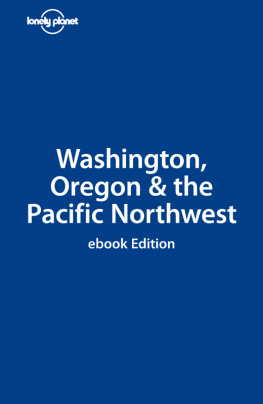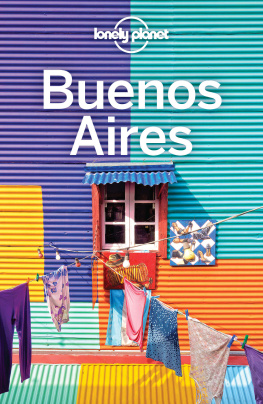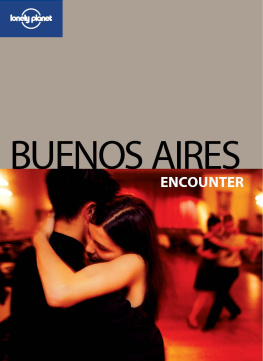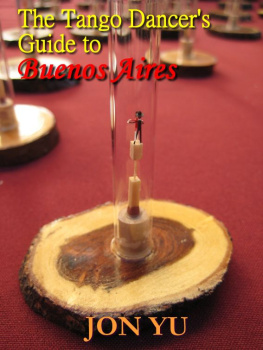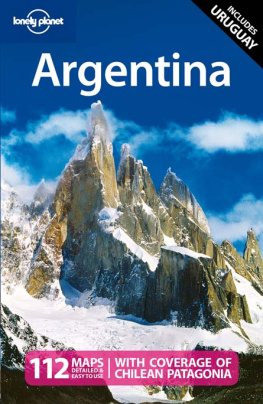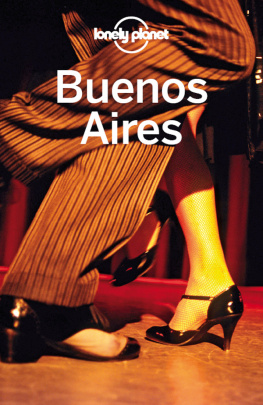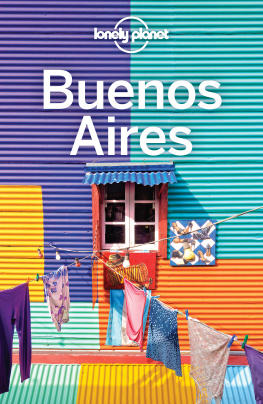THE AUTHORS
Sandra Bao

Sandras mom and her family escaped Chinas communist regime in the years following WWII, eventually boarding a freighter bound for Argentina in 1952. After months at sea they arrived in Buenos Aires just two days after the death of Evita Pern. With the nation in mourning, their luggage wasnt processed for a week. Sandras dad had a better welcome in 1955, when he came over from England, where hed been studying.
Sandras parents met in Montevideo, Uruguay, got married and moved to Olivos, Buenos Aires, where they raised two kids, Sandra and her brother Daniel. They lived the carefree porteo life (with asados every Sunday) until 1974, when things started to get politically dicey. Once again the Baos emigrated to greener pastures this time the USA and got into California real estate at just the right time.
Sandra is proud to be a portea and has often returned to her homeland. As well as writing all of this guidebook (apart from the Background chapter) Sandras also contributed to Argentina and South America on a Shoestring.
SANDRAS TOP BUENOS AIRES DAY
Its Sunday morning, so like most other porteos I get up around noon not bad for having stayed up till 5am the night before. I nurse my hangover with t negro (black tea) and a couple of medialunas (croissants) at the local corner caf, then deal with the crazy crowds bustling through San Telmos antiques market. A refreshing walk sounds perfect on this glorious spring day, so I head over to the Reserva Ecolgica Costanera Sur for some bird-watching. After my clearing dose of nature, a visit to Plaza de Mayo and its impressive Casa Rosada is in order. Strolling up Calle Florida means avoiding traffic, so this is what I do, window-shopping all the way (and grabbing a luscious ice-cream cone, too). When I reach the stunning Galeras Pacfico I pop inside for a quick peep at the gorgeous ceiling murals (and take a bathroom break downstairs). Plaza San Martn invites a restful sit-down and makes for some great people-watching on the grassy lawns. Then I head up Av Alvear into upscale Recoleta, where I wander the crafts stalls before ducking into the cemetery for some quiet reflection and awesome photo ops. After catching the 59 bus to Palermo Viejo I find the stores still open, and go on a shopping spree at clothing boutiques. Soon its 10pm and time for dinner, so I meet some friends at one of the dozens of fine restaurants in this neighborhood and start a long night out all over again.
LONELY PLANET AUTHORS
Why is our travel information the best in the world? Its simple: our authors are independent, dedicated travelers. They dont research using just the internet or phone, and they dont take freebies, so you can rely on their advice being well researched and impartial. They travel widely, to all the popular spots and off the beaten track. They personally visit thousands of hotels, restaurants, cafs, bars, galleries, palaces, museums and more and they take great pride in getting all the details right, and telling it how it is. Think you can do it? Find out how at lonelyplanet.com.
Anja Muti

It took one brief sojourn and a single tango class for Anja Muti to fall in love with Buenos Aires. After visiting several South American destinations for work and play, she kept returning to BA, lured by its fresh evening breezes, cozy cafs, underground theater and late-night milongas. She continues to tango in various cities around the world. Anja wrote the Background chapter.
GETTING STARTED
Buenos Aires is a cosmopolitan city, and you can expect to find pretty much all the modern conveniences and services youre used to. Theres a plethora of accommodations in nearly all neighborhoods that are popular with tourists, and they range from countless hostels to five-star hotels such as the Hilton, Four Seasons and Sofitel. There are also dozens of lovely guesthouses to choose from, including several gay-friendly options. Its always a good idea to reserve ahead of time and pretty much mandatory during the busier November to March and July to August seasons. At other times there are usually a few rooms available at all but the most popular places. That said, dont come to BA during major holidays such as Christmas or Easter without reservations.
BA eateries cater to all budgets you can nab a choripn (spicy sausage sandwich) for AR$3, or pay international prices at the most expensive restaurants. As a whole, Argentine cuisine isnt hugely creative typical fare consists of steak or pasta. Buenos Aires, however, has a fairly good range of (pricier) exotic cuisines, especially in its Palermo Viejo neighborhood.
Most traveler services are easily found in the center, including internet cafs, telephone offices and laundries. Its easy to get from one area to another using the Subte, buses or taxis. Many people speak some English, especially those in the tourist sectors.
WHEN TO GO
In terms of weather, spring (September to November) and fall (March to May) are the best seasons to visit Buenos Aires. Also, most festivals take place during these months, as do a good chunk of sporting events. Winter can be cold but not freezing, and a fine time to visit the citys theaters, museums and cafs.
Many tourists come during the late spring and summer (November to March), though the hottest months of January and February are usually unpleasantly humid. Porteos who can afford it leave the city for the coasts, so some places like museums and entertainment venues close down in the capital (January and February are also the worst months to be doing business here). However, no matter what time of year you visit, BA will have something exciting to offer.
FESTIVALS
There are festivals happening in Buenos Aires all the time, and they celebrate nearly everything tango, horses, gauchos, cinema, art, wine, fashion and books. Spring is when the lions share of these events occur.
Check with tourist offices for a list of national holidays.
ADVANCE PLANNING
Buenos Aires has become a very popular destination, so book your hotel in advance to ensure a roof above your head. In fancier hotels youll also save a few bucks off those outrageous rack rates.
Most restaurants dont require advance reservations, but if you want to eat at a popular place (especially on weekends) then be sure to call ahead. We note in individual reviews whether reservations are recommended at a particular place; in general, the fancier a restaurant the more likely youll need a reservation.
Some websites can help you plan ahead and catch special events: Visit www.whatsupbuenosaires.com for hip music happenings, or www.bue.gov.ar for general information and upcoming events. To find reviewed restaurants see www.saltshaker.net and click on the restaurants link under categories.
If youre a do-it-yourselfer with an MP3 player and dont need a tour guide but would still appreciate some guidance, check out www.MPTours.com. You can download unique self-guided tours and maps of BA neighborhoods for US$19.99 each, walking, stopping and listening at your leisure. The city (www.bue.gov.ar/audioguia; both in English and Spanish) also has free downloads.
Finally, try to pack some smart clothing in your bag. Porteos are a well-dressed and well-groomed lot, and youll definitely stick out as a tourist in loud shirt, shorts and flip-flops (in fact, porteos hardly ever wear shorts at all unless theyre working out). Especially if youre going out at night, dress to impress everyone else will.



